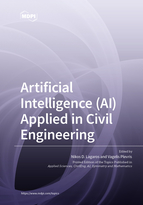Topic Menu
► Topic MenuTopic Editors


Artificial Intelligence (AI) Applied in Civil Engineering

A printed edition is available here.
Topic Information
Dear Colleagues,
In recent years, artificial intelligence (AI) has drawn significant attention with respect to its applications in several scientific fields, varying from big data handling to medical diagnosis. The use of AI is already present in our everyday lives with several applications, such as personalized ads, virtual assistants, autonomous driving, etc. Nowadays, AI techniques are widely used in several forms of engineering applications.
It is our great pleasure to invite you to contribute to this topic by presenting your results on applications and advances of AI to civil engineering problems. The papers can focus on applications related to structural engineering, transportation engineering, geotechnical engineering, hydraulic engineering, environmental engineering, coastal and ocean engineering and structural health monitoring, as well as construction management. Articles submitted to this Topic could also be concerned with the most significant recent developments on the topics of AI and their application in civil engineering. The papers can present modeling, optimization, control, measurements, analysis, and applications.
Prof. Dr. Nikos D. Lagaros
Dr. Vagelis Plevris
Topic Editors
Keywords
- deep learning
- IoT and real-time monitoring
- optimization
- learning systems
- mathematical and computational analysis
Participating Journals
| Journal Name | Impact Factor | CiteScore | Launched Year | First Decision (median) | APC |
|---|---|---|---|---|---|

Applied Sciences
|
2.7 | 4.5 | 2011 | 16.9 Days | CHF 2400 |

CivilEng
|
- | 2.0 | 2020 | 37.7 Days | CHF 1200 |

AI
|
- | - | 2020 | 20.8 Days | CHF 1600 |

Symmetry
|
2.7 | 4.9 | 2009 | 16.2 Days | CHF 2400 |

Mathematics
|
2.4 | 3.5 | 2013 | 16.9 Days | CHF 2600 |

MDPI Topics is cooperating with Preprints.org and has built a direct connection between MDPI journals and Preprints.org. Authors are encouraged to enjoy the benefits by posting a preprint at Preprints.org prior to publication:
- Immediately share your ideas ahead of publication and establish your research priority;
- Protect your idea from being stolen with this time-stamped preprint article;
- Enhance the exposure and impact of your research;
- Receive feedback from your peers in advance;
- Have it indexed in Web of Science (Preprint Citation Index), Google Scholar, Crossref, SHARE, PrePubMed, Scilit and Europe PMC.

